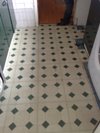 |
| Article
> Do I Really Need to Count the Teaspoons? |
| |
How to produce a useful
inventory
If you let furnished or part-furnished property, an
inventory is now an essential document to protect
you, and your tenant, from lengthy and potentially
expensive arguments further down the line.
Once
upon a time, landlords could choose not to bother
with an inventory, or to keep them exceedingly brief:
we once saw one for a bedsit that read, in its entirety,
"bed; table; chair". But not any more. End-of-tenancy
disputes are becoming more common every year, as deposit
schemes mean that landlords can no longer simply insist
that their version of the contents and condition of
the property is the correct one. It's in everyone's
interest to have the end of the tenancy concluded
as quickly and simply as possible, without prolonged
arguments and even expensive legal disputes. Documenting
what's in the property when the tenant moves in, and
what condition it's in, helps to achieve that.
Making a list, checking it twice...
An inventory should generally cover everything in
the property: furniture, soft furnishings like curtains,
carpets and rugs, electrical and gas appliances, and
lighting fixtures. Make a note of the condition of
each item, and describe any damage: this can be crucial
if, at the end of the tenancy, you wish to withhold
a damage deposit but your tenant denies that any damage
has been caused.
Once
you've created the inventory, you and your new tenant
should check it together, both initialling each page
of the document and signing the last page to confirm
agreement. Both of you should retain a copy of the
inventory through the life of the tenancy. If changes
are made – for example, replacement furniture
– these should be recorded as an emendation
to the inventory.
So
what level of detail do you need? Do you, in fact,
need to count the teaspoons? I know one landlord who
records light bulbs on his inventories, but then I
know of more than one tenant who's moved out and taken
the light bulbs with them, so I'm not altogether against
the idea of putting light bulbs on an inventory.
If
you've just provided a beautiful brand new set of
cutlery, you should certainly record that, but if
it's more like an agglomeration of bits that tenants
have been leaving behind for the last twenty years,
then perhaps "drawerful of assorted cutlery"
would cover things adequately.
Do
remember to include a description of the decor, again
including its condition. Whether the ceilings were
originally painted black or not can be an important
thing to have recorded if there is disagreement over
the return of a deposit.
|
Photograph
damage
Listing the existence of a scratch or chip on
the inventory might seem like enough for now,
but three years down the line, will you really
remember it? If you think the "few small
scratches" on a table have turned into
several large scratches, but your tenant swears
up and down that it's in the same condition
it always was, it's still your word against
hers and the inventory hasn't really helped
anyone. A photograph, on the other hand, stops
all arguments.
Burn
all the photographs relating to the property
to a CD and keep one copy (plus a back-up) for
yourself, and give your tenant another. That
way it's always been part of the official documentation,
and your tenant knows the record exists. This
again should help to keep arguments at the end
of the tenancy to a minimum.
|


|
|
Wear and Tear
Though landlords are entitled to make deductions from
tenants' deposits both for damage and for the property
being left in a dirty state, they are not entitled to
do so for normal and reasonable wear and tear. Naturally,
there is often disagreement between landlords and tenants
as to what constitutes damage, and what is fair wear
and tear. A brand new kitchen fitted at the beginning
of the tenancy, for example, is never going to be returned
in a brand new state at the end of the tenancy, however
good care your tenant has taken of it. Tiny scratches
on a worktop would be inevitable wear and tear, but
larger burns, cuts or stains in the surface could be
classed as damage, and the cost of a replacement worktop
deducted from the deposit. Similarly, some surface wear
to upholstery or carpets is normal, but a series of
rips and cigarette burns would certainly be deductable.
A detailed description of contents plus photographs
will help to draw a fair distinction between reasonable
wear and tear on the one hand, and damaged property
on the other.
Do I need a professional inventory clerk?
There are companies who will prepare and check inventory
for you at the beginning and end of a tenancy. These
can be useful for a landlord who lives some distance
from their property or out of the country altogether,
but for most people, preparing an inventory is something
you can easily do yourself, so long as you take the
time to do it thoroughly.
Everything else you need to know
It’s worth spending the time to go through the
inventory with your tenant. It might be tempting to
give them a copy and tell them to check and sign it
in their own time, but going through things with them
will stop any arguments, either now or at the end of
the tenancy.
While
you're checking over the property with your tenant,
it's worth pointing out or listing other features they'll
need to know about: water, gas and electricity meters,
the stop cock and the fuse box. If you do get a burst
pipe, knowing that your tenant knows how to shut the
water off should give everyone a little extra piece
of mind.
|
If you just need to find a
tenant, Upad doesn’t make you sign up for months
of expensive management contract: we just find you
a tenant. We’ll list your property on more than
500 UK lettings sites, including Rightmove, Zoopla,
FindaProperty as well as Gumtree and local media sites
in your area.
For
a one-off fee of £69, it stays advertised until
you’ve found a tenant. There are no hidden extras,
no fees for tenants, just your property advertised
everywhere your next tenant might be looking.
Visit www.upad.co.uk to get started.
To
find your next tenant CLICK
HERE |
| |
|
| |
|
| |
|

|
|
|
 |
|
 |
My
Property Power Team recommends Upad, the UK's largest
online lettings agent.

Upad's
Rental Property Marketing helps you find a tenant
for your rental property quickly and easily, by
distributing your ad to over 500 top UK property
websites. To find your next tenant
CLICK HERE
|
|
 |
 |

Some
Key Stats
*
Upad.co.uk generates on average 14 enquires
per listing.
*
Upad.co.uk has built the largest rental property
marketing distribution network in the UK
*
Upad.co.uk has the largest database of private landlord
customers of any online lettings business
|
|
 |
|

